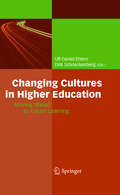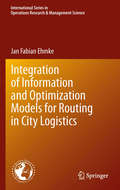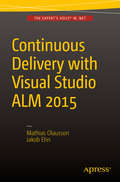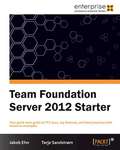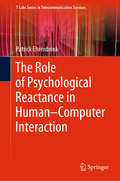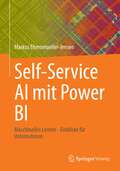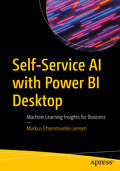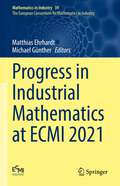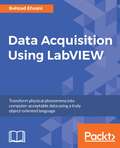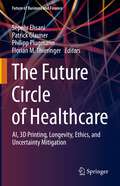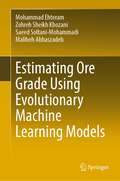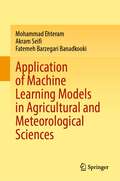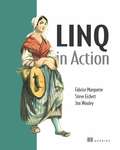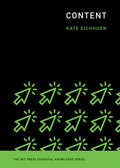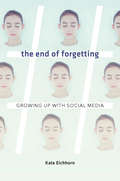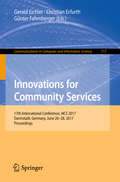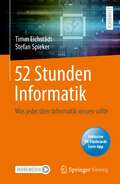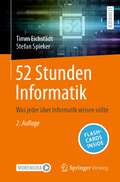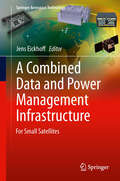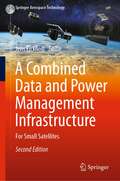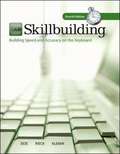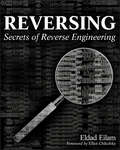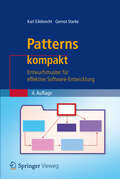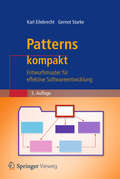- Table View
- List View
Changing Cultures in Higher Education: Moving Ahead to Future Learning
by Ulf-Daniel Ehlers Dirk SchneckenbergMore and more educational scenarios and learning landscapes are developed using blogs, wikis, podcasts and e-portfolios. Web 2.0 tools give learners more control, by allowing them to easily create, share or reuse their own learning materials, and these tools also enable social learning networks that bridge the border between formal and informal learning. However, practices of strategic innovation of universities, faculty development, assessment, evaluation and quality assurance have not fully accommodated these changes in technology and teaching. Ehlers and Schneckenberg present strategic approaches for innovation in universities. The contributions explore new models for developing and engaging faculty in technology-enhanced education, and they detail underlying reasons for why quality assessment and evaluation in new - and often informal - learning scenarios have to change. Their book is a practical guide for educators, aimed at answering these questions. It describes what E-learning 2.0 is, which basic elements of Web 2.0 it builds on, and how E-learning 2.0 differs from Learning 1.0. The book also details a number of quality methods and examples, such as self-assessment, peer-review, social recommendation, and peer-learning, using illustrative cases and giving practical recommendations. Overall, it offers a step-by-step guide for educators so that they can choose their own quality assurance or assessment methods, or develop their own evaluation methodology for specific learning scenarios. The book addresses everyone involved in higher education - university leaders, chief information officers, change and quality assurance managers, and faculty developers. Pedagogical advisers and consultants will find new insights and practices for the integration and management of novel learning technologies in higher education. The volume fosters in lecturers and teachers a sound understanding of the need and strategy for change, and it provides them with practical recommendations on competence and quality methodologies.
Integration of Information and Optimization Models for Routing in City Logistics
by Jan Fabian EhmkeAs urban congestion continues to be an ever increasing problem, routing in these settings has become an important area of operations research. This monograph provides cutting-edge research, utilizing the recent advances in technology, to quantify the value of dynamic, time-dependent information for advanced vehicle routing in city logistics. The methodology of traffic data collection is enhanced by GPS based data collection, resulting in a comprehensive number of travel time records. Data Mining is also applied to derive dynamic information models as required by time-dependent optimization. Finally, well-known approaches of vehicle routing are adapted in order to handle dynamic information models. This book interweaves the usually distinct areas of traffic data collection, information retrieval and time-dependent optimization by an integrated methodological approach, which refers to synergies of Data Mining and Operations Research techniques by example of city logistics applications. These procedures will help improve the reliability of logistics services in congested urban areas.
Continuous Delivery with Visual Studio ALM 2015
by Jakob Ehn Mathias OlaussonThis book is the authoritative source on implementing Continuous Delivery practices using Microsoft's Visual Studio and TFS 2015. Microsoft MVP authors Mathias Olausson and Jakob Ehn translate the theory behind this methodology and show step by step how to implement Continuous Delivery in a real world environment. Building good software is challenging. Building high-quality software on a tight schedule can be close to impossible. Continuous Delivery is an agile and iterative technique that enables developers to deliver solid, working software in every iteration. Continuous delivery practices help IT organizations reduce risk and potentially become as nimble, agile, and innovative as startups. What you'll learn What Continuous Delivery is and how to use it to create better software more efficiently using Visual Studio 2015 How to use Team Foundation Server 2015 and Visual Studio Online to plan, design and implement powerful and reliable deployment pipelines Detailed step by step instructions for implementing Continuous Delivery on a real project Who this book is for Developers, Release Engineers, Architects, Product Managers Table of Contents 1. Introduction to Continuous Delivery 2. Overview of Visual Studio ALM 2015 3. Designing an application for Continuous Delivery 4. Managing the Release Process 5. Source Control Management 6. PowerShell for Deployment 7. Build Automation 8. Managing Code Quality 9. Continuous Testing 10. Building a deployment pipeline 11. Measure and learn
Team Foundation Server 2012 Starter
by Jakob Ehn Terje SandstromThis Starter guide is a short, sharp introduction to Team Foundation Server 12, covering everything you need to get up and running. If you are a developer, project lead, tester, or IT administrator working with Team Foundation Server 2012 this guide will get you up to speed quickly and with minimal effort.
The Role of Psychological Reactance in Human–Computer Interaction (T-Labs Series in Telecommunication Services)
by Patrick EhrenbrinkThis book provides an in-depth investigation on the psychological phenomenon "reactance“ in the context of Human-Computer Interaction (HCI). The author argues that the complexity and autonomy of modern technology can sometimes be overwhelming and can then be perceived as a threat to freedom by its users, thereby diminishing acceptance. The book investigates if and how this is the case and provides strategies to regain the lost acceptance. Topics include relevance of reactance on HCI, triggers for reactance, consequences of reactance, measurement of reactance, and countermeasures to reactance.
Self-Service AI mit Power BI: Maschinelles Lernen - Einblicke für Unternehmen
by Markus Ehrenmueller-JensenIn diesem Buch wird erklärt, wie Sie die in Power BI Desktop geladenen Daten durch den Zugriff auf eine Reihe von Funktionen der künstlichen Intelligenz (KI) anreichern können. Diese KI-Funktionen sind in Power BI Desktop integriert und helfen Ihnen, neue Erkenntnisse aus vorhandenen Daten zu gewinnen. Einige der Funktionen sind automatisiert und stehen Ihnen auf Knopfdruck oder durch das Schreiben von Datenanalyseausdrücken (DAX) zur Verfügung. Andere Funktionen sind durch das Schreiben von Code in den Sprachen R, Python oder M verfügbar. Dieses Buch eröffnet Ihnen die gesamte Palette der KI-Funktionen mit klaren Beispielen, die zeigen, wann sie am besten angewendet werden und wie Sie sie auf Ihre eigenen Datensätze anwenden können. Ganz gleich, ob Sie Geschäftsanwender, Analyst oder Datenwissenschaftler sind - Power BI verfügt über KI-Funktionen, die auf Sie zugeschnitten sind. In diesem Buch erfahren Sie, welche Arten von Erkenntnissen Power BI automatisch liefern kann. Sie erfahren, wie Sie die Sprachen R und Python für Statistiken integrieren und nutzen können, wie Sie beim Laden von Daten mit Cognitive Services und Azure Machine Learning Services zusammenarbeiten, wie Sie Ihre Daten durch Fragen in einfachem Englisch erkunden können ... und vieles mehr! Es gibt KI-Funktionen für die Entdeckung Ihrer Daten, die Charakterisierung unerforschter Datensätze und die Erstellung von Was-wäre-wenn-Szenarien. Es gibt viel zu mögen und von diesem Buch zu lernen, ob Sie ein Neuling in Power BI oder ein erfahrener Benutzer sind. Power BI Desktop ist ein frei verfügbares Tool zur Visualisierung und Analyse. Dieses Buch hilft Ihnen, das Beste aus diesem Tool herauszuholen, indem Sie einige seiner neuesten und fortschrittlichsten Funktionen nutzen. Was Sie lernen werden: - Stellen Sie Fragen in natürlicher Sprache und erhalten Sie Antworten aus Ihren Daten - Lassen Sie sich von Power BI erklären, warum sich ein bestimmter Datenpunkt von den anderen unterscheidet - Lassen Sie Power BI die wichtigsten Einflussfaktoren über Datenkategorien anzeigen - Zugriff auf die in der Azure-Cloud verfügbaren Funktionen für künstliche Intelligenz - Gehen Sie denselben Drilldown-Pfad in verschiedenen Teilen Ihrer Hierarchie - Laden Sie Visualisierungen, um Ihre Berichte intelligenter zu gestalten - Simulieren Sie Änderungen an Daten und sehen Sie sofort die Folgen - Kennen Sie Ihre Daten, noch bevor Sie Ihren ersten Bericht erstellen - Erstellen Sie neue Spalten, indem Sie Beispiele für die benötigten Daten angeben - Transformieren und visualisieren Sie Ihre Daten mit Hilfe von R- und Python-Skripten Für wen dieses Buch gedacht ist: Für den begeisterten Power BI-Anwender, der modernste Funktionen der künstlichen Intelligenz (KI) einsetzen möchte, um neue Erkenntnisse aus vorhandenen Daten zu gewinnen. Für Endanwender und IT-Fachleute, die sich nicht scheuen, in die neue Welt des maschinellen Lernens einzutauchen, und bereit sind, diesen Schritt zu tun und einen tieferen Blick in ihre Daten zu werfen. Für diejenigen, die von einfachen Berichten und Visualisierungen zu diagnostischen und prädiktiven Analysen übergehen wollen.
Self-Service AI with Power BI Desktop: Machine Learning Insights for Business
by Markus Ehrenmueller-JensenThis book explains how you can enrich the data you have loaded into Power BI Desktop by accessing a suite of Artificial Intelligence (AI) features. These AI features are built into Power BI Desktop and help you to gain new insights from existing data. Some of the features are automated and are available to you at the click of a button or through writing Data Analysis Expressions (DAX). Other features are available through writing code in either the R, Python, or M languages. This book opens up the entire suite of AI features to you with clear examples showing when they are best applied and how to invoke them on your own datasets.No matter if you are a business user, analyst, or data scientist – Power BI has AI capabilities tailored to you. This book helps you learn what types of insights Power BI is capable of delivering automatically. You will learn how to integrate and leverage the use of the R and Python languages for statistics, how to integrate with Cognitive Services and Azure Machine Learning Services when loading data, how to explore your data by asking questions in plain English ... and more! There are AI features for discovering your data, characterizing unexplored datasets, and building what-if scenarios.There’s much to like and learn from this book whether you are a newcomer to Power BI or a seasoned user. Power BI Desktop is a freely available tool for visualization and analysis. This book helps you to get the most from that tool by exploiting some of its latest and most advanced features.What You Will LearnAsk questions in natural language and get answers from your dataLet Power BI explain why a certain data point differs from the restHave Power BI show key influencers over categories of dataAccess artificial intelligence features available in the Azure cloudWalk the same drill down path in different parts of your hierarchyLoad visualizations to add smartness to your reportsSimulate changes in data and immediately see the consequencesKnow your data, even before you build your first reportCreate new columns by giving examples of the data that you needTransform and visualize your data with the help of R and Python scriptsWho This Book Is ForFor the enthusiastic Power BI user who wants to apply state-of-the-art artificial intelligence (AI) features to gain new insights from existing data. For end-users and IT professionals who are not shy of jumping into a new world of machine learning and are ready to make that step and take a deeper look into their data. For those wanting to step up their game from doing simple reporting and visualizations by making the move into diagnostic and predictive analysis.
Progress in Industrial Mathematics at ECMI 2021 (Mathematics in Industry #39)
by Matthias Ehrhardt Michael GüntherThis book gathers peer-reviewed contributions submitted to the 21st European Conference on Mathematics for Industry, ECMI 2021, which was virtually held online, hosted by the University of Wuppertal, Germany, from April 13th to April 15th, 2021. The works explore mathematics in a wide variety of applications, ranging from problems in electronics, energy and the environment, to mechanics and mechatronics. Topics covered include: Applied Physics, Biology and Medicine, Cybersecurity, Data Science, Economics, Finance and Insurance, Energy, Production Systems, Social Challenges, and Vehicles and Transportation. The goal of the European Consortium for Mathematics in Industry (ECMI) conference series is to promote interaction between academia and industry, leading to innovations in both fields. These events have attracted leading experts from business, science and academia, and have promoted the application of novel mathematical technologies to industry. They have also encouraged industrial sectors to share challenging problems where mathematicians can provide fresh insights and perspectives. Lastly, the ECMI conferences are one of the main forums in which significant advances in industrial mathematics are presented, bringing together prominent figures from business, science and academia to promote the use of innovative mathematics in industry.
Radio and the Gendered Soundscape
by Christine EhrickThis book is a history of women, radio, and the gendered constructions of voice and sound in Buenos Aires, Argentina, and Montevideo, Uruguay. Through the stories of five women and one radio station, this study makes a substantial theoretical contribution to the study of gender, mass media, and political culture and expands our knowledge of these issues beyond the US and Western Europe. Included here is a study of the first all-women's radio station in the Western Hemisphere, an Argentine comedian known as 'Chaplin in Skirts', an author of titillating dramatic serials and, of course, Argentine First Lady 'Evita' Perón. Through the concept of the gendered soundscape, this study integrates sound studies and gender history in new ways, asking readers to consider both the female voice in history and the sonic dimensions of gender.
Data Acquisition Using LabVIEW
by Behzad EhsaniTransform physical phenomena into computer-acceptable data using a truly object-oriented language About This Book • Create your own data acquisition system independently using LabVIEW and build interactive dashboards • Collect data using National Instrument's and third-party, open source, affordable hardware • Step-by-step real-world examples using various tools that illustrate the fundamentals of data acquisition Who This Book Is For If you are an engineer, scientist, experienced hobbyist, or student, you will highly benefit from the content and examples illustrated in this book. A working knowledge of precision testing, measurement instruments, and electronics, as well as a background in computer fundamentals and programming is expected. What You Will Learn • Create a virtual instrument which highlights common functionality of LabVIEW • Get familiarized with common buses such as Serial, GPIB, and SCPI commands • Staircase signal acquisition using NI-DAQmx • Discover how to measure light intensity and distance • Master LabVIEW debugging techniques • Build a data acquisition application complete with an installer and required drivers • Utilize open source microcontroller Arduino and a 32-bit Arduino compatible Uno32 using LabVIEW programming environment In Detail NI LabVIEW's intuitive graphical interface eliminates the steep learning curve associated with text-based languages such as C or C++. LabVIEW is a proven and powerful integrated development environment to interact with measurement and control hardware, analyze data, publish results, and distribute systems. This hands-on tutorial guide helps you harness the power of LabVIEW for data acquisition. This book begins with a quick introduction to LabVIEW, running through the fundamentals of communication and data collection. Then get to grips with the auto-code generation feature of LabVIEW using its GUI interface. You will learn how to use NI-DAQmax Data acquisition VIs, showing how LabVIEW can be used to appropriate a true physical phenomenon (such as temperature, light, and so on) and convert it to an appropriate data type that can be manipulated and analyzed with a computer. You will also learn how to create Distribution Kit for LabVIEW, acquainting yourself with various debugging techniques offered by LabVIEW to help you in situations where bugs are not letting you run your programs as intended. By the end of the book, you will have a clear idea how to build your own data acquisition system independently and much more. Style and approach A hands-on practical guide that starts by laying down the software and hardware foundations necessary for subsequent data acquisition-intensive chapters. The book is packed full of specific examples with software screenshots and schematic diagrams to guide you through the creation of each virtual instrument.
The Future Circle of Healthcare: AI, 3D Printing, Longevity, Ethics, and Uncertainty Mitigation (Future of Business and Finance)
by Sepehr Ehsani Patrick Glauner Philipp Plugmann Florian M. ThieringerThe past decade has brought to the fore the critical need to constantly envision and consider various scenarios where ongoing trends and sudden changes could together alter the provision of healthcare and the direction of medical research. This book brings together scholars whose areas of expertise represent different themes that are essential to understanding how healthcare might change and evolve over the next decade. What lessons can one take away from current and past developments? The themes explored by the book rest on four pillars. The first is the rapid pace and ubiquity of technological advances in areas such as artificial intelligence, machine learning, additive manufacturing and wearable electronics. The second pillar concerns healthy aging, longevity and the management of chronic diseases. The third is the imperative to remain cognizant of the ethical dimensions of medical decisions, adapting bioethics to ongoing changes in healthcare provision. Finally, the fourth pillar relates to how uncertainty in different domains of medical knowledge can be mitigated and translated into clinical practice. For example, how should uncertainty with the results of clinical trials for a new treatment be dealt with? What cost-benefit analyses would be most appropriate for the situation? Chapter authors identify respective challenges and promising opportunities, discussing how these could contribute to envisioning the future scope of healthcare when it comes to providing medical, economic and ethical values to human societies.Chapters 1, 4, 12, and 20 are available open access under a Creative Commons Attribution 4.0 International License via link.springer.com.
Estimating Ore Grade Using Evolutionary Machine Learning Models
by Mohammad Ehteram Zohreh Sheikh Khozani Saeed Soltani-Mohammadi Maliheh AbbaszadehThis book examines the abilities of new machine learning models for predicting ore grade in mining engineering. A variety of case studies are examined in this book. A motivation for preparing this book was the absence of robust models for estimating ore grade. Models of current books can also be used for the different sciences because they have high capabilities for estimating different variables. Mining engineers can use the book to determine the ore grade accurately. This book helps identify mineral-rich regions for exploration and exploitation. Exploration costs can be decreased by using the models in the current book. In this book, the author discusses the new concepts in mining engineering, such as uncertainty in ore grade modeling. Ensemble models are presented in this book to estimate ore grade. In the book, readers learn how to construct advanced machine learning models for estimating ore grade. The authors of this book present advanced and hybrid models used to estimate ore grade instead of the classic methods such as kriging. The current book can be used as a comprehensive handbook for estimating ore grades. Industrial managers and modelers can use the models of the current books. Each level of ore grade modeling is explained in the book. In this book, advanced optimizers are presented to train machine learning models. Therefore, the book can also be used by modelers in other fields. The main motivation of this book is to address previous shortcomings in the modeling process of ore grades. The scope of this book includes mining engineering, soft computing models, and artificial intelligence.
Application of Machine Learning Models in Agricultural and Meteorological Sciences
by Mohammad Ehteram Akram Seifi Fatemeh Barzegari BanadkookiThis book is a comprehensive guide for agricultural and meteorological predictions. It presents advanced models for predicting target variables. The different details and conceptions in the modelling process are explained in this book. The models of the current book help better agriculture and irrigation management. The models of the current book are valuable for meteorological organizations. Meteorological and agricultural variables can be accurately estimated with this book's advanced models. Modelers, researchers, farmers, students, and scholars can use the new optimization algorithms and evolutionary machine learning to better plan and manage agriculture fields. Water companies and universities can use this book to develop agricultural and meteorological sciences. The details of the modeling process are explained in this book for modelers. Also this book introduces new and advanced models for predicting hydrological variables. Predicting hydrological variables help water resource planning and management. These models can monitor droughts to avoid water shortage. And this contents can be related to SDG6, clean water and sanitation. The book explains how modelers use evolutionary algorithms to develop machine learning models. The book presents the uncertainty concept in the modeling process. New methods are presented for comparing machine learning models in this book. Models presented in this book can be applied in different fields. Effective strategies are presented for agricultural and water management. The models presented in the book can be applied worldwide and used in any region of the world. The models of the current books are new and advanced. Also, the new optimization algorithms of the current book can be used for solving different and complex problems. This book can be used as a comprehensive handbook in the agricultural and meteorological sciences. This book explains the different levels of the modeling process for scholars.
LINQ in Action
by Steve Eichert James B. Wooley Fabrice MarguerieLLINQ, Language INtegrated Query, is a new extension to the Visual Basic and C# programming languages designed to simplify data queries and database interaction. It addreses O/R mapping issues by making query operations like SQL statements part of the programming language. It also offers built-in support for querying in-memory collections like arrays or lists, XML, DataSets, and relational databases.LINQ in Action is a fast-paced, comprehensive tutorial for professional developers. This book explores what can be done with LINQ, shows how it works in an application, and addresses the emerging best practices. It presents the general purpose query facilities offered by LINQ in the upcoming C# 3.0 and VB.NET 9.0 languages. A running example introduces basic LINQ concepts. You'll then learn to query unstructured data using LINQ to XML and relational data with LINQ to SQL. Finally, you'll see how to extend LINQ for custom applications.LINQ in Action will guide you along as you explore this new world of lambda expressions, query operators, and expression trees. As well, you'll explore the new features of C# 3.0, VB.NET 9.0. The book is very practical, anchoring each new idea with running code. Whether you want to use LINQ to query objects, XML documents, or relational databases, you will find all the information you need to get startedBut LINQ in Action does not stop at the basic code. This book also shows you how LINQ can be used for advanced processing of data, including coverage of LINQ's extensibility, which allows querying more data sources than those supported by default. All code samples are built on a concrete business case. The running example, LinqBooks, is a personal book cataloging system that shows you how to create LINQ applications with Visual Studio 2008. Purchase of the print book comes with an offer of a free PDF, ePub, and Kindle eBook from Manning. Also available is all code from the book.
Content (The MIT Press Essential Knowledge series)
by Kate EichhornA concise introduction to content and the content industry, from the early internet to the Instagram egg.From the time we roll out of bed to check overnight updates to our last posts, likes, and views of the previous day, we're consuming and producing content. But what does the term &“content&” even mean? When did it become ubiquitous? And at what cost? In this volume in the MIT Press Essential Knowledge series, Kate Eichhorn offers a concise introduction to content and the content industry, examining the far-reaching effects content has on culture, politics, and labor in a digital age. Eichhorn traces the evolution of our current understanding of content from the early internet to the current social mediaverse. The quintessential example of content, she says, is the Instagram egg—an image that imparted no information or knowledge and circulated simply for the sake of circulation. Eichhorn explores what differentiates user-generated content from content produced by compensated (although often undercompensated) workers; examines how fields from art and literature to journalism and politics have weathered the rise of the content industry; and investigates the increasing importance of artists&’ &“content capital&”—the ability of artists, writers, and performers to produce content not about their work but about their status as artists.
The End of Forgetting: Growing Up with Social Media
by Kate EichhornThanks to Facebook and Instagram, our younger selves have been captured and preserved online. But what happens, Kate Eichhorn asks, when we can’t leave our most embarrassing moments behind? Rather than a childhood cut short by a loss of innocence, the real crisis of the digital age may be the specter of a childhood that can never be forgotten.
Innovations for Community Services
by Gerald Eichler Christian Erfurth Günter FahrnbergerThis book constitutes the refereed proceedings of the 16th International Conference on Innovations for Community Services, I4CS 2016, held in Vienna, Austria, in June 2016. The 12 revised full papers presented together with two short papers were carefully reviewed and selected from 30 submissions. The papers are organized in topical sections on navigation and data management; monitoring and decision making; coding and security; collaboration and workflow; routing and technology; topic and object tracking.
52 Stunden Informatik: Was jeder über Informatik wissen sollte
by Timm Eichstädt Stefan SpiekerDas Buch vermittelt Allgemeinbildung der Informatik. Alle 52 Lektionen haben einen starken praktischen Bezugzeigen Konzepte/Tools/Technologien auf dem aktuellen Stand der Technikbeschreiben zentrale Begriffe der Informatik mit Erläuterungen, Beispielen, praktischen Übungen, Hinweisen, Diskussionspunkten und weiterführenden Linkssind vom Umfang überschaubar (circa 1 Stunde)Die Priorität liegt auf aktuellen Inhalten und wertvollem Grundlagenwissen mit vielen praktischen Beispielen und Ideen zur Wissensvermittlung. Zusätzlich stehen für Leserinnen und Leser über die Springer Nature Flash-cards-App digitale Lernkarten zum Buch zur Wissenskontrolle und -vertiefung kostenlos zur Verfügung.
52 Stunden Informatik: Was jeder über Informatik wissen sollte
by Timm Eichstädt Stefan SpiekerHaben Sie in Ihrer Schulzeit keinen oder nur mangelhaften Informatikunterricht erhalten? Haben Sie Kinder und würden diese gerne auf das bevorstehende Informationszeitalter vorbereiten? Nehmen Sie sich in den nächsten 52 Wochen je eine Stunde Zeit um mithilfe dieses Buches ein solides Grundwissen über Informatik zu schaffen! 52 Stunden Informatik enthält eine breit gefächerte Zusammenstellung von Lektionen, zum Lernen bzw. Lehren von Grundwissen der Informatik. Vom Nutzen des Internets bis hin zur Informationssicherheit, von deskriptiver Statistik bis hin zum neuronalen Netz sind viele wichtige Aspekte der Informatik abgedeckt. Alle Lektionen enthalten pädagogisch wertvolle Hinweise und sind mit praktischen Übungen versehen. Eine Pflichtlektüre für alle praxisorientierten Informatiklehrer*innen und Eltern, die selbst einen angemessenen Informatikunterricht verpasst haben. Die neue Auflage aktualisiert und erweitert viele Kapitel (z.B. ist das Thema "ChatGPT" im Kapitel über künstliche Intelligenz mit aufgenommen) und enthält ein neues Kapitel über 3D-Druck.
A Combined Data and Power Management Infrastructure: For Small Satellites (Springer Aerospace Technology)
by Jens EickhoffThis book describes the development and design of a unique combined data and power management infrastructure The use in small satellites gives some particular requirements to the systems like potential hardware failure robustness and handling of different types of external analog and digital interfaces. These requirements lead to a functional merge between On Board Computer and the satellite's Power Control and Distribution Unit, which results in a very innovative design and even a patent affiliation. This book provides system engineers and university students with the technical knowledge as mix between technical brochure and a user guide.
A Combined Data and Power Management Infrastructure: For Small Satellites (Springer Aerospace Technology)
by Jens EickhoffThis book describes the development and design of a unique combined data and power management infrastructure for small satellites. This new edition became necessary because in the frame of the system's impressive evolution from an academic prototype to one of today's most advanced core avionics, many elements were upgraded to their next technology generation and diverse new components complement the upgraded design. All elements are presented in updated respectively new chapters. This modular infrastructure was selected by the Swiss start-up ClearSpace SA for ESA's first mission ClearSpace-1 to remove space debris. Furthermore it is the baseline for the Thai national satellite development program and is used by an increasing number of universities worldwide for research studies.
SKB Skillbuilding: Building Speed and Accuracy on the Keyboard,Fourth Edition
by Carole Hoffman Eide Andrea Holmes Rieck V. Wayne KleminThis book provides you with a thoroughly tested program to improve your proficiency in using a personal computer, word processor, typewriter, or any other machine with a similar keyboard.
Reversing
by Eldad EilamBeginning with a basic primer on reverse engineering-including computer internals, operating systems, and assembly language-and then discussing the variousapplications of reverse engineering, this book provides readers with practical, in-depth techniques for software reverse engineering. The book is broken into two parts, the first deals with security-related reverse engineering and the second explores the more practical aspects of reverse engineering. In addition, the author explains how to reverse engineer a third-party software library to improve interfacing and how to reverse engineer a competitor's software to build a better product.* The first popular book to show how software reverse engineering can help defend against security threats, speed up development, and unlock the secrets of competitive products* Helps developers plug security holes by demonstrating how hackers exploit reverse engineering techniques to crack copy-protection schemes and identify software targets for viruses and other malware* Offers a primer on advanced reverse-engineering, delving into "disassembly"-code-level reverse engineering-and explaining how to decipher assembly language
Patterns kompakt
by Karl Eilebrecht Gernot StarkePatterns kompakt fasst die wichtigsten Entwurfsmuster zusammen, die Sie für Software-Entwicklung benötigen. Software-Entwickler, -Architekten und -Designer finden darin effektiv anwendbare Lösungen für tägliche Entwurfsprobleme. Die vierte Auflage wurde um aktuelle Patterns erweitert und komplett überarbeitet. Das Buch gliedert Patterns anhand typischer Aspekte des Software-Entwurfs: Basismuster für mehr Flexibilität und Wartbarkeit, Präsentation, Kommunikation und Verteilung, Integration und Persistenz. Patterns kompakt richtet sich an Praktiker: Software-Entwickler, -Designer, -Architekten und alle, die einen praxisorientierten Überblick zu Entwurfsmustern benötigen.
Patterns kompakt: Entwurfsmuster für effektive Softwareentwicklung (IT kompakt)
by Karl Eilebrecht Gernot StarkePatterns kompakt fasst die wichtigsten Entwurfsmuster zusammen, die Sie für Softwareentwicklung benötigen. Softwareentwickler und -architekten finden darin effektiv anwendbare Lösungen für tägliche Entwurfsprobleme. Das Buch gliedert Patterns anhand typischer Aspekte des Softwareentwurfs: - Basismuster für mehr Flexibilität und Wartbarkeit- Präsentation- Kommunikation und Verteilung- Integration- PersistenzDie nunmehr fünfte (aktualisierte und erweiterte) Auflage enthält darüber hinaus ein Kapitel zum Thema Software-Inbetriebnahme.Patterns kompakt richtet sich an Praktiker: Softwareentwickler, -architekten sowie alle, die einen praxisorientierten Überblick zu Entwurfsmustern benötigen.
